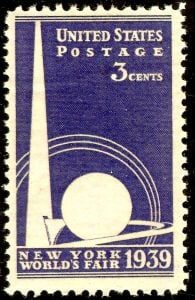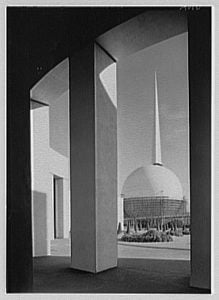1939: Industrial Design and Functionalism

Postage Stamp picturing the Trylon and Perisphere, 1939
In terms of shaping the fair’s aesthetics, the New York World’s Fair Corporation relied on standouts in the up and coming field of industrial design. Specifically the Board of Design called on such industrial designers as Gilbert Rohde, Raymond Loewy, Egmond Argens, Donald Deskey and Henry Dreyfuss to design the fair’s focal exhibits and to define its zones. Ultimately, Flushing Meadows became divided into a Transportation Zone, a Communications and Business Systems Zone, a Government zone, a Food Zone and an Amusement Area.

View of the 1939 theme buildings, The Trylon and Perisphere by Samuel Gottscho, 1939.
In contrast to the typically neoclassical fairs of the nineteenth century, the 1939 fair favored modernist architecture. Specifically, the fair’s final designs were heavily influenced by
functionalism and by the growing International Style ; an architectural movement popularized by Phillip Johnson and Le Corbusier that emphasized rectilineal shapes and smooth, unadorned planes and curves.
Undeniably, the most celebrated design came from Wallace Harrison in his Trylon and Perisphere. These buildings, pictured at right, became the symbol of the fair and were reproduced as stamps, postcards, t-shirts, scale models and similar iconic objects like the ones on display at The City Reliquary. The Trylon, stood 610 feet tall and the Perisphere, measured 180 feet in diameter. In fact, many visitor accounts mention simply viewing these famous structures as a highlight of the fair.